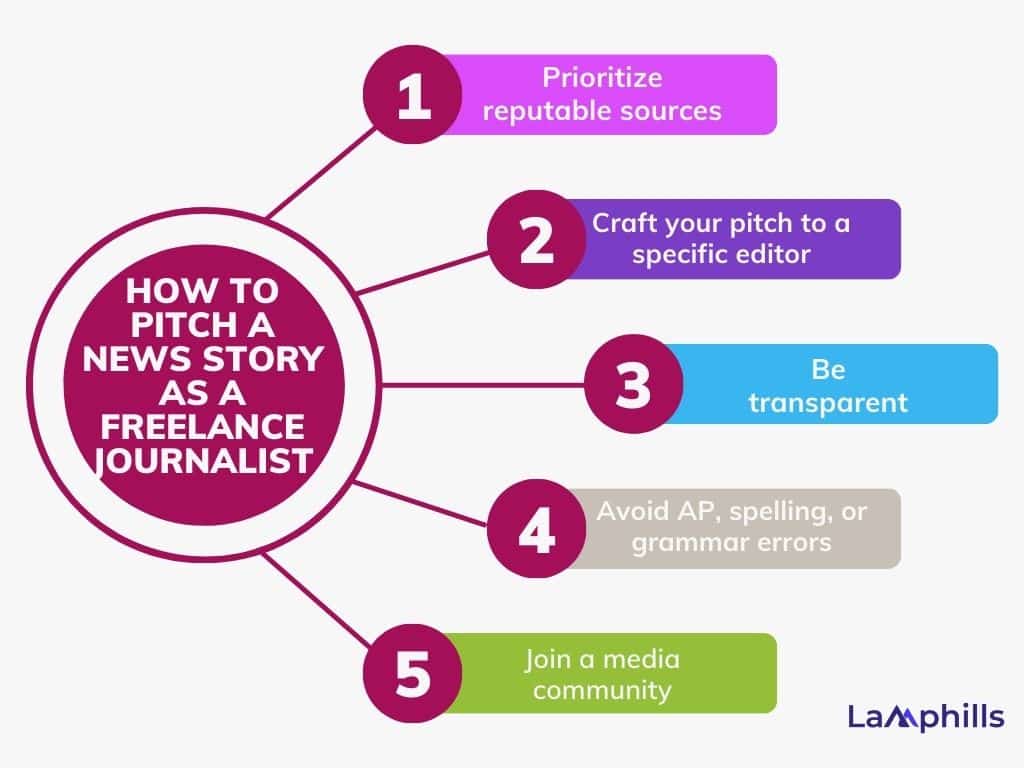When you want to pitch a story to a news editor, there are certain elements you need to adopt to ensure you grab their attention. Most notable is your headline – it is the first thing the editor sees, and will determine whether or not they continue reading your story or discard it immediately.
This means that your headline must be concise but interesting enough to be eye-catching without giving away too much. After all, if the audience can already glean the entire story from the headline alone, what’s the point of reading further?
While this is the most important factor that determines the success of your pitch to a news editor, it is but one of several others.
Key Takeaways
- A story pitch is a brief description, usually no longer than 500 words or two paragraphs, intended to convince an editor, agent or publisher to commission the piece.
- An effective pitch should be concise yet compelling, typically ranging from a few sentences to a short paragraph.
- For professional writers, knowing how to pitch a story helps get their work published and develop professional relationships with publishers, editors and agents.
- Tailoring the pitch to align with the publication’s style and content demonstrates your familiarity with the outlet, enhancing the likelihood of acceptance.
- If, at the end of it all, you’re still having difficulty pitching stories, you can join a media community to meet other journalists and editors.
What Is A Story Pitch?
A story pitch is a brief description, usually no longer than 500 words or two paragraphs, intended to convince an editor, agent or publisher to commission the piece. Writers in various industries use pitches to encourage an organization to publish their work.
Though the exact content included in a pitch depends on what kind of industry you work in, most pitches include:
- An introduction that describes your story, conflict and point of view
- An explanation of what differentiates your story from others and makes it important or interesting
- An expected deadline for the piece
- Your contact information
- A sample of your work
For example, a journalist may email the editor of a newspaper or magazine to explain an idea for an article. The editor decides if the article idea fits their publication and if the journalist has the right qualifications to produce the piece. Similarly, a scriptwriter may pitch a screenplay to a movie producer by describing the plot and characters.
How Long Should A Pitch Be?
An effective pitch should be concise yet compelling, typically ranging from a few sentences to a short paragraph. The goal is to capture the essence of your idea while piquing the journalist’s interest: “Pitches with body lengths between 50 to 150 words had nearly double the average overall response rate at 5.06%.”
Think of it as an elevator ride: you have limited time to make an impression, so every word should count. Ideally, your pitch should quickly convey the core of your story, its unique angle, and why it’s relevant to the publication or audience, all without overwhelming the recipient with excessive detail. If they’re intrigued, they’ll ask for more.
How to Pitch A News Story to an Editor
Before you begin, keep these in mind: journalists and editors are flooded with press releases, media pitches, and various other demands on their time and attention. Based on research from Fractl, 46.5% of journalists receive at least 11 media pitches per day, while 28.64% receive over 26 pitches daily.
Hence, knowing what to include in your media pitch—and what to leave out—will greatly improve your chances of getting a reply. Keep in mind that even a single typo in a cold pitch is enough to turn possibility into disaster.
Start with an engaging hook or statistic to grab their attention. Clearly articulate your proposed piece’s main angle or unique perspective, demonstrating its relevance to the media outlet’s audience. Highlight potential sources or unique insights you’ll bring, and conclude by briefly establishing your credentials or experience related to the topic.
Tailoring the pitch to align with the publication’s style and content demonstrates your familiarity with the outlet, enhancing the likelihood of acceptance.
How to pitch a news story to an editor
How to Pitch a News Story To An Editor: Email Template
Opening: Engaging hook or stat
Immediately capture the editor’s attention and make them want to read more. You make your first impression here, so it should be compelling and relevant.
- Use a Shocking Statistic: Find a surprising statistic related to your topic. For example, if your pitch is about the decline of bee populations, you might start with, “Did you know that 40% of our pollinating insects, particularly bees, are facing extinction?”
- Tell a Brief Story: Share a quick anecdote or story that epitomizes your main point. This personalizes the pitch and can humanize more abstract concepts.
- Ask a Provocative Question: Pose a question that challenges conventional wisdom or assumptions about your topic.
Middle: The main idea or angle
This is where you outline the crux of your story or idea. It’s essential to convey not just what you want to talk about but also the unique angle or perspective you intend to bring to it.
Tips:
- Be Clear and Concise: You don’t have a lot of space, so get to the point. Clearly state what your piece will cover.
- Offer a Fresh Angle: Make sure your pitch isn’t just a generic topic overview. What makes your story idea different? What kind of story haven’t readers seen before?
- Include Potential Sources: If you have access to unique sources or interviews, mention them. It shows the editor that you’ve done your homework and adds credibility to your pitch.
Closing: Why it’s relevant and who you are
It’s time to persuade the editor that your story is timely and important, and that you are the right person to write it.
- Connect to Current Events or Trends: Show the editor that your story angle is relevant to what’s happening now. For instance, if you pitch a story about remote work, you might mention recent surveys or studies highlighting its rising popularity. Does this news greatly affect an industry that’s relevant to the journalist’s readers?
- Highlight Your Credentials: Briefly mention any experience, education, or background that makes you particularly suited to write on this topic. This isn’t just about flaunting your achievements but showing the editor that you bring a level of expertise or unique perspective to the table.
- End with Enthusiasm: Express your eagerness or passion for the topic. Let the editor know that you’re not just looking for an assignment but that you’re genuinely excited to delve into this subject and build a partnership.
Here’s a template for pitching a story in an email:
Story pitch email template
How To Pitch A News Story As A Freelance Journalist
If you’re a freelance writer working in the age of digital journalism, we don’t have to tell you twice: drafting a story is only half the battle. The true challenge comes during the pitching stage when you have to race against the clock to get a story published while it’s still timely for readers.
Struggling to master the art of the pitch? Here are five tactics to remember for selling stories as a freelance journalist to media outlets.

#1. Prioritize reputable sources
Whether you’re pitching a news story, an idea or a completed story, reputable sources are critical for capturing an editor’s attention. Even if they love your style or concept, they can’t put their outlet’s name on your piece without proof of authentic references.
If you’ve secured an interview with a top-notch expert or witness, put their name and your connection to them at the top of your pitch. You already know never to bury the headline, so the same rule applies to sources.
#2. Craft your pitch to a specific editor at a specific outlet
You shouldn’t send the same copy-and-pasted pitch to everyone on your target list. Each outlet has its own unique set of readers, and each editor has a specific taste and tone.
When you draft the pitch, always include references to the outlet’s latest coverage and why your story fits the framework. If possible, send it to a specific editor who’s shown interest in the topic in the past.
The more you demonstrate you’ve done the research, the higher the likelihood of receiving a response.
#3. Be transparent about the story
The editors you’re pitching a news story have been around the block many times before. If your pitch frames your story as something it’s not, they’ll notice sooner rather than later – and won’t be happy you mislead them.
Be upfront about the beat, purpose, and takeaway of your story. Never try to pass off an opinion or blog piece as fact-driven reporting, and cite facts about the story in the body of your pitch.
#4. Never submit a story with AP, spelling, or grammar errors
Even if you’re a veteran journalist, it’s worth hearing this reminder time and time again. Everyone makes mistakes – especially fast-paced writers who crank out multiple stories per day – but if an editor catches an AP. spelling, or grammar error, the odds are high that you’ll receive a rejection.
As a freelancer, editors turn to you for stories they don’t have to manage from start to finish. Make their job as easy as possible with air-tight writing, and you might just be rewarded with a reply, or if you’re lucky, publication.
#5. Join a media community
If, at the end of it all, you’re still having difficulty pitching stories, fear not! You don’t have to navigate these choppy waters alone. Even though technology and journalism haven’t always gotten along, there are several tech-driven communities where editors and writers can meet, network, sell, and buy stories. It is every ingredient for successfully pitching a news story packed into one convenient marketplace.
So find a media community and meet people who can help you develop your skills.
How To Pitch A News Story: Common Mistakes to Avoid
- Not doing your homework: Media contacts prefer pitches tailored to their beat and interests. A generic pitch can come off as lazy or irrelevant.
- Writing a lengthy pitch: Journalists are swamped with emails daily. A concise, compelling pitch is more likely to grab their attention.
- Using a dull subject line: The subject line is the first thing a journalist sees. A bland or vague subject line may lead them to skip over your email.
- Not establishing credibility: Journalists want credible, reliable sources. Establishing your expertise or your source’s authority can make your pitch more compelling.
- Making it all about you: Your pitch should emphasize the value to the journalist’s readers or audience, not just what you hope to achieve.
Why Is It Important To Know How To Pitch A Story?
For professional writers, knowing how to pitch a story helps get their work published and develop professional relationships with publishers, editors and agents. Understanding the fundamentals and expectations of pitching a story may help you feel more confident when approaching publishers. It may help you become more successful at getting your ideas accepted.
It’s also essential to know the different ways to pitch a story.
For freelance journalists, it’s common to email editors with your story pitch. Authors or scriptwriters may pitch their work personally at writers’ conferences or when meeting with network producers or directors. Publishers and agents often require authors to pitch their work with a query letter before they read an excerpt or the full piece.
Recommended Articles
- 8+ Communications Skills Every Specialist Needs to Thrive in 2024
- You Have Been Writing Datelines Wrong Your Entire Career! Here is the Right Way…
- 7 Elements of Storytelling: How I Connect with my Audience
- How To Write A Compelling Headline in 9 Steps
- 11 Share of Voice Tools That is Making Marketing Gurus Rage With Envy
- Content Team: How to Build & Grow an Effective Content Team






